Farm Crops
What do these photos tell you about the kind of crops farmers raised?
Melon Day In Rocky Ford (1893)
This photo was taken in 1893 during the Melon Day celebration at Rocky Ford, Colorado. It shows thousands of melons piled up in a long row.
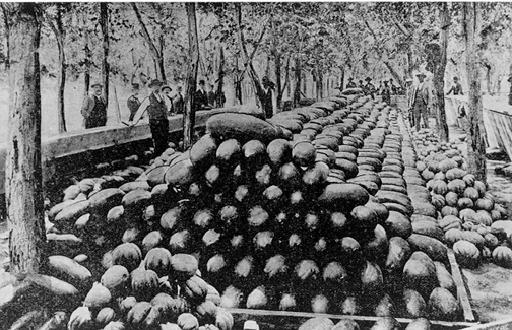
Photo: Colorado Historical Society
More About This Topic
Many farmers in the Arkansas Valley raised melons on their irrigated farms. The soil near Rocky Ford was good for growing watermelons and cantaloupe. By the early 1900s, farmers there shipped Rocky Ford cantaloupe and honey dew melons to cities throughout the United States.
Their Own Words
"In 1874, I put out about 40 acres of land in crops of grains and vegetables, more as an experiment than anything else, to find out what would be the most adapted to our soils, climate, and altitude and found that all kinds of vines did well, especially the cantaloupe. . . . In 1877 I planted a small patch for market, about one quarter of an acre, which produced all I could sell in this market. . . . In 1880, I produced a cantaloupe something like what I wanted and from that by careful selection for many years we produced the present cantaloupe, which is know as the Rocky Ford Cantaloupe, that was near perfect as could well be."
Source: G. W. Swink, "Rocky Ford Melons," Colorado Magazine, 26 (1949): 29.
Digging Potatoes
This photo shows a farmer using a horse-drawn potato digger. It took six horses to pull the digger through the field.
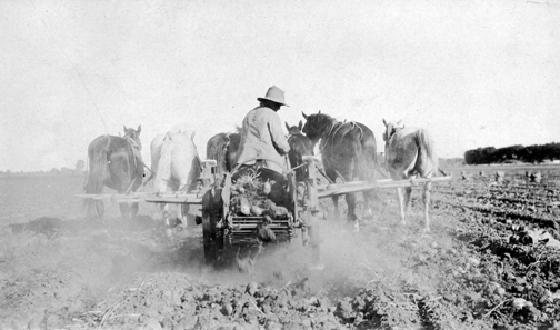
Photo: Denver Public Library, Western History Collection
More About This Topic
Potatoes were one of the first garden vegetables planted in Colorado. Farmers also planted potatoes in large fields. They sold their crop in Denver and in the mining towns in the mountains. In the 1870s, Greeley was a center for potato growing. Later, the San Luis Valley also became an important potato growing region.
Their Own Words
"Potatoes are thus far the great staple in the line of vegetables.... In some instances, a single farmer raises his 50 or 100 acres of potatoes.... Many specimens grow to an immense size--4, 5, and even 6 pounds to the potato being a not uncommon weight.... Mining settlements where vegetables cannot be raised create a large demand and they are the easiest crop transported and kept for winter use."
Source: Rocky Mountain News, April 13, 1864.
A Grand Junction Orchard
This photo was taken in a peach orchard near Grand Junction, Colorado. The farmer is using a hoe to cut weeds from around the peach trees.
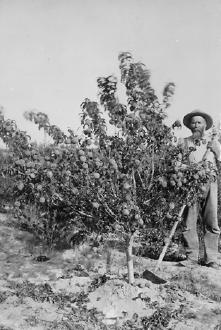
Photo: Colorado Historical Society
More About This Topic
Farmers planted apple, peach, plum, and other fruit trees in many parts of Colorado. When the Western Slope was opened the settlement in the 1880s, settlers also planted fruit trees there. The Grand Junction area, with its long growing season, became the best fruit growing region in Colorado. Palisade peaches were well-known throughout the United States.
Their Own Words
"The development of these [Western Slope] counties has been phenomenal. . . . The fruit growers of these counties place before the public the largest and finest exhibition of fruits ever shown in the state, and the best the writer ever saw in any state. . . . Trees seem to do equally well, whether on the adobe soil of the river bottoms or on the red, sandy loam of the higher mesas."
Source: Charles S. Crandall, State Horticulturalist, Oct. 1891; quoted in Alvin T. Steinel, History of Agriculture in Colorado (Fort Collins: State Agricultural College, 1926): 508.
Cultivating Sugar Beets
This is a sugar beet field. The photo was taken in Colorado in the early 1900s.
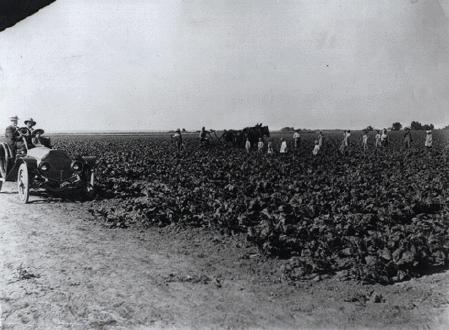
Photo: Denver Public Library, Western History Collection
More About This Topic
Sugar beets became an important crop in Colorado in the early 1900s. Farmers could make more money raising beets than any other field crop. By 1926, Colorado had 17 sugar factories and produced more sugar than any other state. Farmers also discovered that beet tops and beet pulp made good cattle feed. Sugar beet growing helped make cattle feedlots a profitable business in Colorado.
Their Own Words
"It does not take any more water to grow an acre of beets than it does an acre of other crops, and the returns are fully ten times greater per acre."
Source: Senator G. W. Swink to President Theodore Roosevelt, Feb. 1906; quoted in Alvin T. Steinel, History of Agriculture in Colorado (Fort Collins: State Agricultural College, 1926): 304.
Melons & Pumpkins Near Dearfield
This photo was taken at a farm at Dearfield, Colorado. Dearfield was an African-American farming community. The man on the left is O. T. Jackson, who began the community. The crops shown in the photo are pumpkins and, in the rear of the photo, a field of corn.
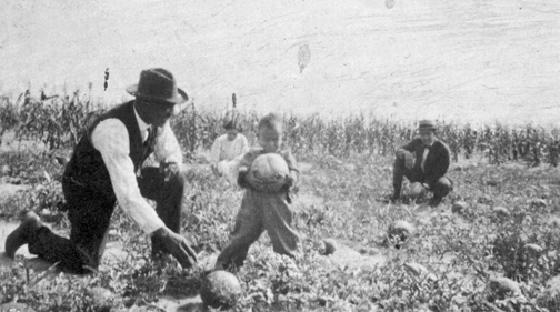
Photo: Colorado Historical Society
More About This Topic
People who settled in Colorado tried to grow crops that they were used to growing back home. These included corn, wheat, pumpkins and other field crops. The African-American farmers who settled at Dearfield, Colorado did that as well. What all of them discovered was that most crops did not do well in Colorado's dry climate unless they were irrigated. The community at Dearfield failed largely for that reason.
Their Own Words
"The first year there were but seven families in the settlement. . . . We managed to get in some garden: corn, melons, pumpkins, squash, Mexican beans and some hay, and cleared some ground of sagebrush. We raised quite a lot of chickens, ducks, and turkeys. By assisting each other we managed to raise and store away enough produce to run us part way through the winter, which was a very cold one."
Source: O. T. Jackson, quoted in Karen Waddell, "Dearfield. . . A Dream Deferred," Colorado Heritage, 2 (1988): 5.
A Field Of Grain
This is a photo of a field of winter wheat taken somewhere in eastern Colorado.
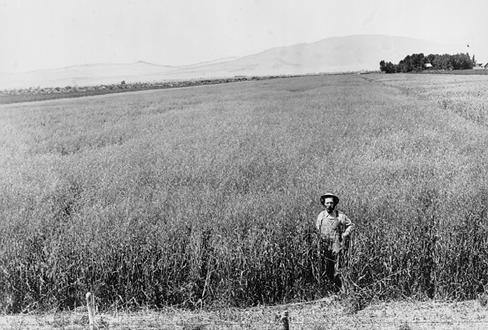
Photo: Colorado Historical Society
More About This Topic
Winter wheat became an important crop in eastern Colorado because it could be grown without irrigation. Winter wheat is planted in the fall. It comes up the next spring when the ground is still moist form spring rains. It is harvested before the hot months of the summer begin.
Their Own Words
"It was soon discovered that corn was an unreliable crop for dry land farming…. If we had a fairly good snow cover in the winter, a couple of good rains in the spring months would almost always produce a crop of wheat."
Source: Glen R. Durrell, "Homesteading in Colorado," Colorado Magazine, 51 (1974): 98.

